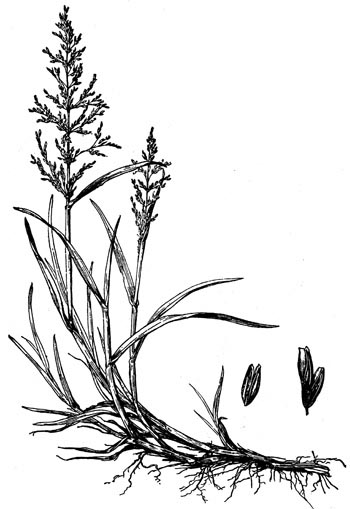Brookgrass

Common Name(s):
Brookgrass
Water Whorlgrass
Water Hairgrass
Scientific Name:
Catabrosa aquatica (L.) Beauv.
Scientific Name Synonyms:
Aira aquatica L.
Catabrosa aquatica (L.) Beauv. var. uniflora S.F. Gray
Symbol:
CAAQ3
Description:
Life Span: Perennial
Origin: Native
Season: Cool
Growth Characteristics: Brookgrass is a creeping, aquatic perennial that is slightly bent at the base. Branching and rooting occurs at the nodes of the reclining appearing base. Flowering occurs during late June through September.
Seedhead: Flowerhead is an open pyramid-shaped or oblong-shaped panicle, 4-8 inches in height. The branches of panicle spreading in whorls (appear to arise from the same area). The spikelets are small, 1/16-1/8 inch long, most containing 2 distinct flowers, but 1-5 are possible. The 1st glume is blunt, shorter than the floret, nerveless and membranous. A 2nd glume exists, considerably larger than first, 1/32-1/16 inch long. The lemmas are unawned, with 3 prominent nerves on the back.
Leaves: Blades flat, 1/16-3/8 inch wide, sheathes closed about half their length; ligules membranous, 1/16-3/8 inch long; auricles lacking;
Stems: 4-16 inches tall; often prostrate or decumbent; hairless.
Ecological Adaptions:
Found in wet mountain meadows, edges of lakes, springs, and along streams at elevations between 4200-10200 feet.
Soils: Wet soils.
Associated Species: Quaking Aspen, Blue Spruce, Subalpine Fir, and ponderosa pine
Uses and Management:
Brookgrass can produce severe acid poisoning in cattle if consumed in large quantities. It acts as a soil stabilizer by catching sediments with its fine root system and is a reliable indicator of perennial springs. It is grazed by cattle and horses, but very seldom by sheep. Owing to the low stature and its limited distribution and abundance, as well as its restriction to wet soils, it is not important as forage.

